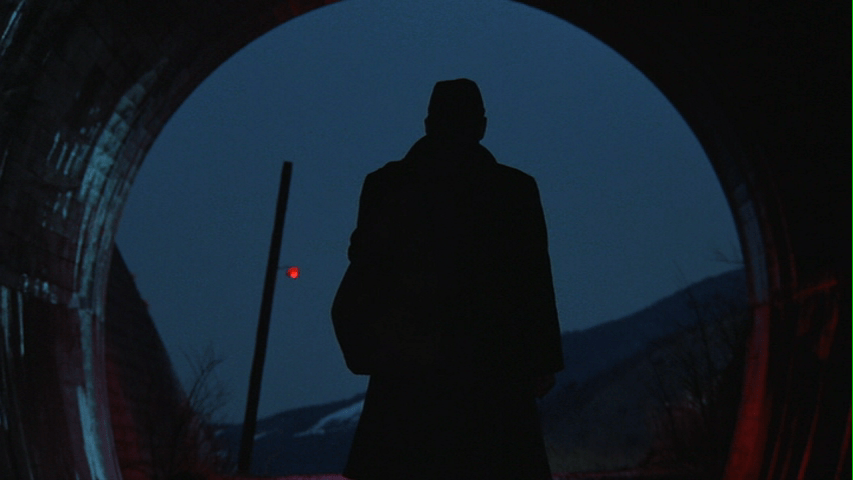The Tunnel
As this poet becomes unconscious a stratum is formed and in this layer, memory is a demon that walks like a soldier from a tunnel.
This is the last stanza in my poem ’Nostalghia‘, about Tarkovsky’s 1983 film of the same name, but this image is directly from The Tunnel sequence in Kurosawa’s Dreams, a film made up of sequences based on Kurosawa’s own, real dreams. In this sequence, a lone army general, walking along a lonely road, comes to a tunnel.

’The Tunnel‘ sequence from Kurosawa’s Dreams (1990).
From the tunnel this general is first confronted by a German shepherd, wearing a loaded dynamite coat. It is an anti-tank dog. The dog snarls and barks at him, but eventually quells.
Next, a blue-skinned young soldier emerges. It becomes clear that he is dead but does not yet know he is dead. He knows the general because he was in his platoon. He is still seeking orders. The general becomes visibly upset as he realises this is a young soldier who was shot and fainted, whom he tended to; the young soldier died not long after regaining consciousness. The general explains this to the young soldier, seeking to help him orientate to the fact that he is not alive. Finally, in an act of generous comradeship, he assumes the role of general once more and salutes him before commanding him to about-face and march back into the tunnel, effectively giving peace to the restless soul. An important lesson has just played out. As viewers, we understand he is coming to terms with repressed pain that is re-emerging.
There is a pause, and then, stunningly, the entire platoon emerges from the tunnel. Forty or fifty blue-faced soldiers, waiting for orders. The general explains to them that they are dead, that ’Platoon Three was entirely annihilated,’ and that it was he who had sent them to their deaths. He expresses regret, and again assists them in finding peace by ordering them to about-face and march back into the dark tunnel. Again, the viewer understands what has been achieved.
The scene ends when the anti-tank dog confronts him again, barking and snarling, showing its teeth. It leaves him with the dog forever harassing him. He does not even attempt to command the animal …
In Tarkovsky’s Nostalghia there too is a big German shepherd, or Alsatian, but I never mention Kurosawa’s bomb dog in my poems (I’m only noticing this now); I subconsciously linked the two film dogs and only deployed in the poem what Kurosawa’s dog meant: memory. With Tarkovsky, I was still on a level of looking at the images, but with Kurosawa, I understood the actual meaning and instinctively knew I didn’t need to re-interrogate his symbol.
Tarkovsky’s Stalker also has a tunnel, which represents a huge psychological test for anyone to travel through. The tunnel is so arduous to endure that it is nicknamed ‘the meat mincer’ for its ability to destroy the human psyche. The character who braves the tunnel is the one called Writer, played by Tarkovsky’s favourite actor, Solonitsyn. To some extent, Kurosawa’s tunnel better explains Tarkosky’s tunnel, and Kurosawa’s dog explains to me Tarkovsky’s dog. The writing of the poems was the way I came to this understanding, but I did not consciously set this as the purpose for writing it. This is the mystery of the entire process for me.
’The Tunnel’ is perhaps my favourite of the eight sequences in Dreams, and this image of the weaponised dog is exquisite. But another sequence that my mind has put a tiny flag in is ‘The Blizzard’, where a party of mountaineers presses through a raging ice storm. Their leader (the dreamer, the ‘I’ in the film) constantly encourages them on, yelling at them not to give up. But eventually, they fall down in the snow, exhausted. We remain psychically with the leader as he starts to die.
At this point, a snow demon appears in the form of a beautiful woman whose long, black hair whips around in the ferocious wind. She comforts him and covers him with her magical, sparkling shawl, all the while reassuring him with the eerie words: ‘The snow is warm. The ice is hot.’ As the mountaineer begins to succumb, the demon gradually changes its appearance from that of the beautiful young woman to its real form, with its clearly demonic and ravenous facial expression.
The mountaineer fights the demon off! He lives. He awakes and shouts at his group and rouses them also. Now the blizzard has quelled, they can see their camp not far away! There it is! And they trudge again towards their now-visible goal. The scene ends on them making their way to the camp, but we never witness them arriving, entering. Kurosawa, the great director, dreams about generals and leaders and pushing people through arduous situations. Maybe Kurosawa had this dream while having trouble finishing a film.
I have a belief that if I visualised the mountaineers get to the tent, I would eventually finish another poem, one that would somehow be about hot and cold, and the self-deception of not finishing, of not wanting to finish, of having to constantly rouse yourself not to give up on something almost understood, but not yet understood.










Pingback: Catching up a bit… | Poems about Tarkovsky films